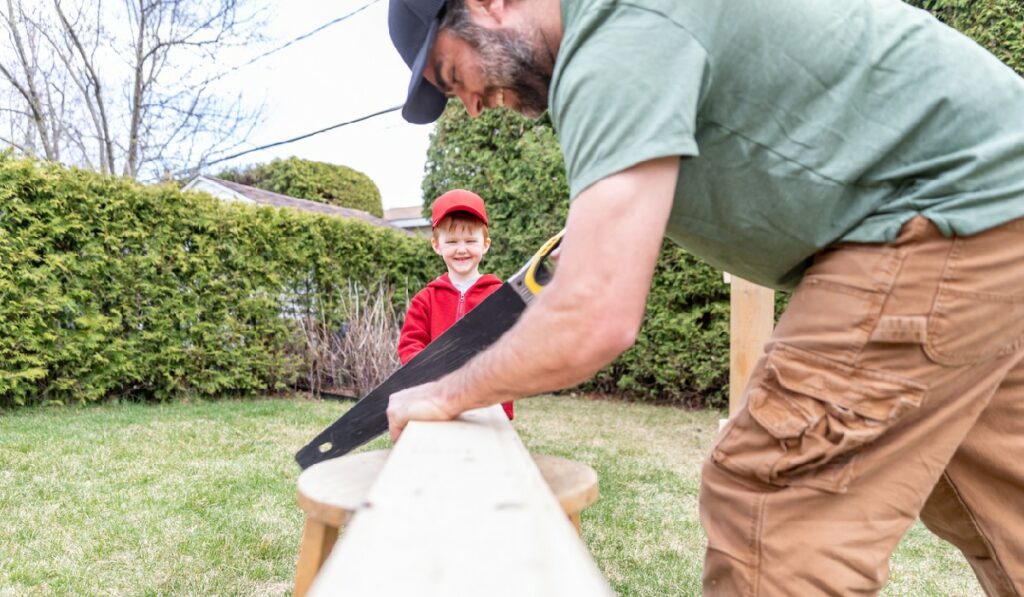Back to Basics: How to Master Using a Handsaw for Cutting Wood

Using a handsaw is an essential skill for any DIYer, especially if you’re into outdoor activities like camping and hiking. Not only is it versatile, but it’s also incredibly lightweight and easy to carry. But if you’re a newbie to using a handsaw for cutting wood, it can be a bit challenging at first. That’s why we’ll be walking you through the basics of using a handsaw, so you can master the skill in no time.
Our goal is to provide you with the confidence and knowledge you need to use a handsaw for any project. We’ll go over the basics, like how to choose the right saw, how to sharpen the blade, and even a few tips and tricks on how to get the most out of your saw. So let’s get started and explore the world of handsaw woodworking!
What is a Handsaw?
A handsaw is a saw that is typically used for cutting wood and other materials by hand. It is made up of a blade with several teeth and is used in both carpentry and other do-it-yourself projects. It can come in various sizes and shapes depending on the job it needs to perform.
There are several different types of handsaws available, each designed for specific tasks. A few examples include crosscut saws, backsaws, ripsaws, panel saws, and keyhole saws. Crosscut saws are best for rough cutting straight lines in wood, while backsaws are ideal for making precise cuts like dovetail joints or miter joints. Ripsaws are best suited for cutting along the grain of wood and are very effective in making rip cuts or cuts parallel with the direction of the grain. Panel saws have wider blades than regular handsaws and are great for cutting large panels of wood quickly and accurately. Finally, keyhole saws are perfect for making intricate curves and tight corners when cutting out door frames or window openings in the wood.
Benefits of Using a Handsaw
Using a handsaw has many advantages over other cutting tools, such as power saws or jigsaws. It is more precise than power saws and often produces less kickback when cutting through thick pieces of wood. Furthermore, using a handsaw requires less setup time than power saws, which also makes it easier to cut multiple pieces at once or make angled cuts with greater accuracy. Lastly – unlike power tools – handsaws can be used in places where electricity may not be accessible such as remote areas or camping sites.
Preparing to Use a Handsaw
When preparing to use a handsaw, it’s important to have the right tools on hand before you get started with your project. This includes having a tape measure and a square ruler to measure and mark up the dimensions of your wood piece before you begin cutting it. Additionally, it’s important to select the right blade for your project; think about the type of cut you will be making to determine whether you need a crosscut blade or rip blade suitable for that task. Finally – if you plan on using an angled cut – ensure you’re using an appropriately-sized miter box as well to ensure accuracy when cutting your pieces at an angle.
Understanding How to Use a Handsaw
Once your preparations are complete, it’s time to start using your hand saw! Start by firmly holding the saw with both hands so that your arms are fully extended when pushing down on the handlebars and pulling away from you when lifting up off the board (this action should be rhythmic). When making precise cuts, such as those with miter boxes or small holes – use short strokes to avoid overcutting around corners and edges if needed. Lastly – use sandpaper or steel wool after each cut so that any splintered or rough areas you may have missed can be smoothed down easily afterward.
Handsaw Maintenance
The last step after completing your project is maintaining your hand saw so that it can continue to provide accurate cuts over time – especially if it’s seen heavy usage between projects! The first step is disassembling the parts from each other and cleaning them thoroughly with water; ensure they dry completely before reattaching them back together again using their locking pins or screws where appropriate (also ensure they’re tightly secured). Then sharpen the teeth of your hand saw by either filing them down manually with a file or using an automated sharpening device like an electric grinder if available; this will help prevent your blade from being dulled prematurely during future cuts! Finally – apply oil onto the surface of the blade regularly so that rust doesn’t form between projects; this will also make subsequent cleanings smoother and quicker!
Conclusion
Whether you’re a novice woodworker or an experienced carpenter, developing the skill of using a handsaw is an invaluable asset in your toolbox. Not only is it lightweight and versatile, but it also produces precise cuts easily and quickly. With practice and patience, anyone can master the art of using a handsaw. With all the tips and tricks outlined in this post, you’ll be ready to tackle your next woodworking project with ease!
